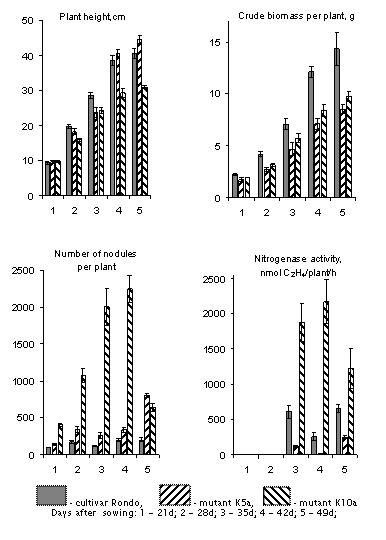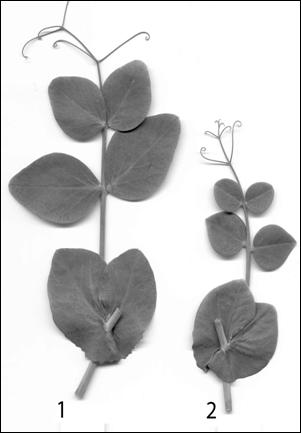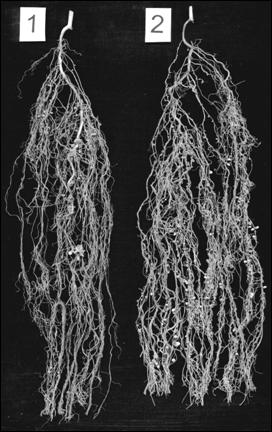
A new pea symbiotic mutant nod7
Sidorova, K.K., Shumny, V.K., Inst. of Cytol. and Genet.
Vlasova, E.Yu., Glianenko М.N.,
Russian Acad. of Sci.,
Gayeva, Т.А. and Mischenko, T.M.
The efficiency of symbiosis is normally assessed by determining root nodule number and nitrogenase activity, each determined once during flowering. A better understanding of the processes of nodulation and nitrogen fixation can be gained by examination of the symbiotic properties of a leguminous plant during ontogenesis. Such an approach may answer the question of how long active nitrogen fixation lasts in different symbiotic genotypes.


A new symbiotic hypernodulating mutant denoted by K5a (nod7) wasinduced from cultivar æRondoÆ by treating seeds with ethylmethanesulfonate. The aim of this work was to examine morphological traits and symbiotic properties at different times during vegetation in Rondo, K5a (nod7) and K10a (nod3, a supernodulating symbiotic mutant).
The trials were carried out in a greenhouse. Plants were grown in pots, 10 in each, with ceramsite as substrate under standard greenhouse conditions (1). Seedlings were inoculated with Rhizobium leguminosarum strain 250a. Plant height, vegetative biomass, nodule counts, and nitrogenase activity were estimated and the phase of development was recorded for each plant on five check days starting from day 21 after sowing (7-8 stem nodes), with 7 day intervals.
Vegetative biomass was reduced in the hypernodulating mutant, K5a, compared to Rondo, although plant height was unaffected (Fig. 1). This effect may be due to K5a plants having very reduced leaves and smaller leaflets and stipules (Fig. 2). Vegetative biomass and plant height were also reduced in the supernodulating mutant, K10a, compared to Rondo.
Late flowering is an important feature of the K5a plants. The onset of flowering was delayed in K5a (day 48 after sowing, check day 3) compared to Rondo and K10a (day 35 after sowing, check day 5). K5a developed more nodules than Rondo. At that phase K5a plants had their maximum nodule counts, about 800 per plant (Fig. 3).
K10a had by far the highest nodule counts, topping 2000 per plant at flowering. Significant differences were observed between K5a and K10a in nitrogenase activity. Nitrogenase activity was very high in K10a, significantly higher that that in Rondo, whereas it was very low in K5a compared to Rondo and especially K10a. Differences were also revealed in the patterns of nodulation. A very sharp enhancement of nodulation was observed in K5a at onset of flowering. In contrast, K10a shows a significant increase in nodule number early during the vegetation period, similar to several other super-nodulating mutants.


|
Fig. 2. Leaves: 1- cultivar Rondo, 2 û hypernodulating mutant K5a. |
Fig. 3. Roots: 1- cultivar Rondo, 2 û hypernodulating mutant K5a. |
1. Sidorova, K.K. and Shumny, V.K. 2003. Genetika 39: 501-509 (in Russian).